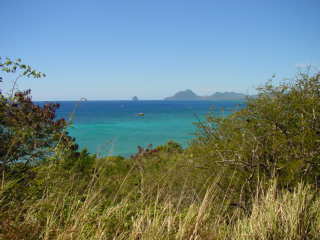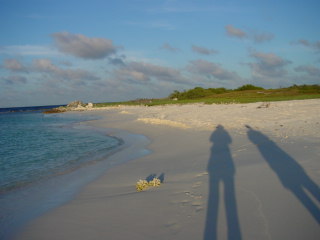Writing from Los Aves
First the great news … Cecile is
working! She went to Canada
to the man who designed her, and he identified a number of manufacturing
errors which he made good, and she is now in fine form.
She has not been tested in really strong weather yet, but all the
signs are good! Her final test run before we reach the Pacific will be going round the north west
Columbian coast,which has a windy reputation, and should take us 4 – 5
days, so we hope that will prove her beyond any doubt.
We
left Martinique a couple of days after collecting and
re-fitting Cecile. We managed
to see some of the island – very mountainous, green and beautiful, with
a curious combination of very French poplars, mixed with palm trees and
bananas! Martinique is
not a French colony, it is a departement of France which we hadn’t
realised, until we saw the inevitable “project funded by the EU”
notices! The food is reputed to be very good, and certainly we were able to buy excellent meat, cheese, etc, but our local restaurants were a
little disappointing.We
took advantage of the rain showers which washed all the salt off the boat
during our first 10 days or so to do quite a bit of painting and
varnishing, since we knew we would have a few weeks to combine work with
relaxing.
We
were anchored in the South of the island, with many of the other yachts
which had crossed the Atlantic at the same time as ourselves.
We all got together for lunch on Christmas Day, each bringing a
contribution.
Because
the weather was uncertain, a kind bar owner allowed us to use his under
cover tables and chairs, right by the sea, so we were all able to land by
dinghy, and of course, with a cover over our heads, the rain kept off!
We
had started the day by going to a very ebullient mass,
held in a newly built, open sided, but roofed church, as the old church is
in a dangerous state of repair. The
bells have been brought to ground level but were
vigorously rung nonetheless. The
choir mistress held a
practice for both congregation and choir for the 15 minutes or so before
the service, so we were able to join in the singing.
The
small town of St Anne had organised a number of Christmas events, many of
which were disrupted by the power workers striking (well, it is France
…) but the sounds of various jazz and steel bands drifted pleasantly
across the anchorage most lunchtimes, and we were also thankfully mostly
disco-free at night.
We
were interested and amused by the stories from the Napoleonic wars, when
Martinique was already French (Josephine’s birthplace, no less), and St
Lucia, just to the south, seemed to change hands between France and England with
great regularity.
|
|
Visible
from the anchorage across the bay was one example – Rocher Diamant - Diamond Rock. As you can see
from the photo, it is very close to the mainland, but the British decided
it would be just where they would station a patrolling ship if they had
one to spare, so they took possession of the rock, fortified it, put a
crew on board and named it HMS Diamond!
They were well placed to take shots at passing French ships.
|

|
|
Napoleon
was incensed by this, and the English version of the story goes that he
sent Admiral Villeneuve across to Martinique to recover the rock, and to
demolish the English fleet, while he was about it.
Nelson
was keen to meet Villeneuve and chased him across the Atlantic, but wrong
information sent him first to Barbados. Villeneuve recovered the rock, but hearing that Nelson was
sailing north towards him,sailed back for France, where he was met with disgrace.
He put to sea again and met Nelson in the battle of Trafalgar!
We can only gasp at such exploits – we certainly did not feel up
to fighting a battle
immediately after crossing the Atlantic!
On
leaving Martinique, we moved south, first stopping briefly in St Lucia,
where we anchored in Rodney Bay (named after Admiral Rodney who sailed
from there to beat the French at the battle of the Saintes), then in Marigot Bay,
with an entrance so well hidden that another English
Admiral was able to hide his fleet from the French (helped it is said by
tying palm trees to their masts!), while the French sailed past in hot
pursuit. Even with GPS, we
only made a positive identification
of the entrance when we saw a yacht come out!
We
sailed on down past St Vincent – a beautiful, wild looking island, again
very green and mountainous – to Bequia, where we also stayed for just a
couple of days. We hired
mountain bikes and rode over to see a one-man
hawksbill turtle conservation project, which was fascinating. “Brother” King started about 5 years ago to rescue the
tiny turtles as they hatched. They
were becoming endangered, and are very difficult to protect as they do not
all go to one, known beach, like many other
types of turtle. He “grows
them on” until they are large enough to have very few predators, which
takes about 2 – 3 years, and then releases them
back into the wild. He must
have had thousands of baby turtles in his sanctuary, and has already
released several hundred.
The
ride out was lovely, though we needed every one of our 21 gears! That night we proved that Bequia can more than hold its own
against Martinique in the restaurant stakes, and at the same time were fascinated to
hear the band sing a song about the “champion whaler man”.
The following morning we set out on the bikes in the opposite
direction, to see the small whaling museum, housed in the said
champion’s house. He died 6
months ago, but limited whaling continues in
Bequia – they take 2 per annum, using two 27 foot sailing cum rowing
boats, each with six crew; hand thrown harpoons, and 130-year old guns to
kill the whales. They use the
meat and oil for food in the islands (“the oil is very good for pea
soup”!), and whatever one may
feel about commercial whaling, it was interesting to find the traditional
methods still in use here.
Now
came Cecile’s longest test so far – a 2½ day sail to the offlying Los
Roques islands of Venezuela. Great relief and a much easier passage as a
result!
|
|
Los
Roques are a number of small islands, protected by a long barrier reef,
which are a Venezuelan national park, due to their bird life.
We saw thousands of pelicans here, patrolling and diving for fish,
as well as many magnificent soaring frigate birds, some of whom we had
noticed on our approach to Martinique, and many other diving birds which
we couldn’t identify.
|

|
|
We
spent hours just watching, and some trying to capture on film, these
extraordinary birds, with their rather clumsy but clearly successful
diving technique. As they bob
to the surface, small seagulls and terns sit on their heads to try to grab
fish from their bills!
We
also started to snorkel over parts of coral reef, seeing more fish than it was possible to remember
afterwards,
to try to identify, although it has been very windy, making the water full
of suspended sand and therefore often not very clear.
Only
one island is inhabited – the others are reef, a few trees and
mile upon mile of white empty sand, with azure water.
It is a real hardship being there!
This
update is being written in the next island group, Los Aves (named
for their birds) very similar to Los Roques – reefs, beaches and
mangroves, but this time with hundreds of thousands of boobies –
graceful diving birds – roosting in the trees and wheeling around us.
We
are on our way to the “ABC” islands and thence to Panama, from
where we will try to send another update before we set off across the
Pacific.
John & Helen
Fleming
Flame of Gosport
3 February 2001
|